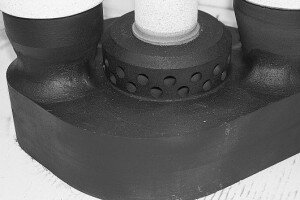Rock Catcher Basics
Rock Catchers are used to keep large chunks of material from interfering with proper pump operation. Rocks, chunks, clumps, are all terms to describe material in the melt that is a bit too large to flow through the impeller’s orifices. Rocks are comprised of:
Chunks of scrap that have not fully melted. These will eventually melt and pass through the Rock Catcher.
Dross chunks that are drawn down by the pump flow. These will need to be removed with periodic cleaning.
Other contamination including hardware dropped in the melt during maintenance.
The addition of a Rock Catcher will reduce peak flow about 5% to 10%, without affecting maximum pump head. The Rock Catcher is integral to the top bearing of the pump base. As a result, it must be installed during manufacturing of the pump base or cartridge. As the Rock Catcher does it's job, the flow will decrease until the rocks are removed through regular maintenance.There are alternatives to Rock Catchers that are applicable in some cases:
Use a larger pump. Although a bit more expense, a larger pump has larger orifices and is less affected by small rocks. Additionally, an oversized pump running at a lower RPM is less likely to be damaged by rocks or blockages.
Use a low-head pump configuration. High-head pumps require tighter tolerances between bearing surfaces as well between the narrowest part of the volute and the impeller. In a low-head pump configuration, these tolerances can be relaxed.
Better furnace maintenance practices.
97% of molten metal pump applications do not require rock catchers; however about 3% benefit.

